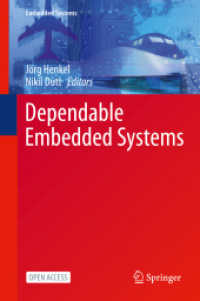- ホーム
- > 洋書
- > 英文書
- > Science / Mathematics
Full Description
An Application-Oriented Introduction to Essential Optimization Concepts and Best Practices
Optimization is an inherent human tendency that gained new life after the advent of calculus; now, as the world grows increasingly reliant on complex systems, optimization has become both more important and more challenging than ever before. Engineering Optimization provides a practically-focused introduction to modern engineering optimization best practices, covering fundamental analytical and numerical techniques throughout each stage of the optimization process.
Although essential algorithms are explained in detail, the focus lies more in the human function: how to create an appropriate objective function, choose decision variables, identify and incorporate constraints, define convergence, and other critical issues that define the success or failure of an optimization project.
Examples, exercises, and homework throughout reinforce the author's "do, not study" approach to learning, underscoring the application-oriented discussion that provides a deep, generic understanding of the optimization process that can be applied to any field.
Providing excellent reference for students or professionals, Engineering Optimization:
Describes and develops a variety of algorithms, including gradient based (such as Newton's, and Levenberg-Marquardt), direct search (such as Hooke-Jeeves, Leapfrogging, and Particle Swarm), along with surrogate functions for surface characterization
Provides guidance on optimizer choice by application, and explains how to determine appropriate optimizer parameter values
Details current best practices for critical stages of specifying an optimization procedure, including decision variables, defining constraints, and relationship modeling
Provides access to software and Visual Basic macros for Excel on the companion website, along with solutions to examples presented in the book
Clear explanations, explicit equation derivations, and practical examples make this book ideal for use as part of a class or self-study, assuming a basic understanding of statistics, calculus, computer programming, and engineering models. Anyone seeking best practices for "making the best choices" will find value in this introductory resource.
Contents
Preface xix
Acknowledgments xxvii
Nomenclature xxix
About the Companion Website xxxvii
Section 1 Introductory Concepts 1
1 Optimization: Introduction and Concepts 3
2 Optimization Application Diversity and Complexity 33
3 Validation: Knowing That the Answer Is Right 53
Section 2 Univariate Search Techniques 59
4 Univariate (Single DV) Search Techniques 61
5 Path Analysis 93
6 Stopping and Convergence Criteria: 1-D Applications 107
Section 3 Multivariate Search Techniques 117
7 Multidimension Application Introduction and the Gradient 119
8 Elementary Gradient-Based Optimizers: CSLSandISD135
9 Second-Order Model-Based Optimizers:SQandNR155
10 Gradient-Based Optimizer Solutions:LM, RLM, CG, BFGS, RG, and GRG173
11 Direct Search Techniques 187
12 Linear Programming 223
13 Dynamic Programming 233
14 Genetic Algorithms and Evolutionary Computation 243
15 Intuitive Optimization 253
16 Surface Analysis II 257
17 Convergence Criteria 2: N-D Applications 265
18 Enhancements to Optimizers 271
Section 4 Developing Your Application Statements 279
19 Scaled Variables and Dimensional Consistency 281
20 Economic Optimization 289
21 Multiple OF and Constraint Applications 305
22 Constraints 319
23 Multiple Optima 335
24 Stochastic Objective Functions 353
25 Effects of Uncertainty 367
26 Optimization of Probable Outcomes and Distribution Characteristics 381
27 Discrete and Integer Variables 391
28 Class Variables 397
29 Regression 403
Section 5 Perspective on Many Topics 441
30 Perspective 443
31 Response Surface Aberrations 459
32 Identifying the Models, OF, DV, Convergence Criteria, and Constraints 475
33 Evaluating Optimizers 489
34 Troubleshooting Optimizers 499
Section 6 Analysis of Leapfrogging Optimization 505
35 Analysis of Leapfrogging 507
Section 7 Case Studies 529
36 Case Study 1: Economic Optimization of a Pipe System 531
37 Case Study 2: Queuing Study 539
38 Case Study 3: Retirement Study 543
39 Case Study 4: AGoddard Rocket Study 551
40 Case Study 5: Reservoir 557
41 Case Study 6: Area Coverage 561
42 Case Study 7: Approximating Series Solution to an ODE 565
43 Case Study 8: Horizontal Tank Vapor-Liquid Separator 571
44 Case Study 9: In Vitro Fertilization 579
45 Case Study 10: Data Reconciliation 585
Section 8 Appendices 591
Section 9 References and Index 717
References and Additional Resources 719
Index 723







